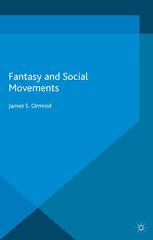
Fantasy and Social Movements PDF
Preview Fantasy and Social Movements
Fantasy and Social Movements StudiesinthePsychosocialSeries EditedbyPeterRedman,TheOpenUniversity,UK,StephenFrosh,CentreforPsychosocial Studies, Birkbeck College, University of London, UK, and Wendy Hollway, The Open University,UK Titlesinclude: StephenFrosh HAUNTINGS:PSYCHOANALYSISANDGHOSTLYTRANSMISSIONS UriHadar PSYCHOANALYSISANDSOCIALINVOLVEMENT InterpretationandAction MargaritaPalacios RADICALSOCIALITY StudiesonViolence,DisobedienceandtheVicissitudesofBelonging DerekHook (POST)APARTHEIDCONDITIONS GathStevens,NormanDuncanandDerekHook(editors) RACE,MEMORYANDTHEAPARTHEIDARCHIVE TowardsaTransformativePsychosocialPraxis IreneBrunaSeu PASSIVITYGENERATION HumanRightsandEverydayMorality LynnChancerandJohnAndrews THEUNHAPPYDIVORCEOFSOCIOLOGYANDPSYCHOANALYSIS KateKennyandMariannaFotaki THEPSYCHOSOCIALANDORGANIZATIONSTUDIES AffectatWork JamesS.Ormrod FANTASYANDSOCIALMOVEMENTS StudiesinthePsychosocialSeries SeriesStandingOrderISBN978–0–230–30858–9(hardback) 978–0–230–30859–6(paperback) (outsideNorthAmericaonly) Youcanreceivefuturetitlesinthisseriesastheyarepublishedbyplacingastandingorder. Pleasecontactyourbookselleror,incaseofdifficulty,writetousattheaddressbelowwith yournameandaddress,thetitleoftheseriesandtheISBNsquotedabove. Customer Services Department, Macmillan Distribution Ltd, Houndmills, Basingstoke, HampshireRG216XS,England AlsobyJamesS.Ormrod COSMICSOCIETY:TOWARDSASOCIOLOGYOFTHEUNIVERSE(co-author) Fantasy and Social Movements James S. Ormrod UniversityofBrighton,UK ©JamesS.Ormrod2014 Softcover reprint of the hardcover 1st edition 2014 978-1-137-34816-6 Allrightsreserved.Noreproduction,copyortransmissionofthis publicationmaybemadewithoutwrittenpermission. Noportionofthispublicationmaybereproduced,copiedortransmitted savewithwrittenpermissionorinaccordancewiththeprovisionsofthe Copyright,DesignsandPatentsAct1988,orunderthetermsofanylicence permittinglimitedcopyingissuedbytheCopyrightLicensingAgency, SaffronHouse,6–10KirbyStreet,LondonEC1N8TS. Anypersonwhodoesanyunauthorizedactinrelationtothispublication maybeliabletocriminalprosecutionandcivilclaimsfordamages. Theauthorhasassertedhisrighttobeidentifiedastheauthorofthiswork inaccordancewiththeCopyright,DesignsandPatentsAct1988. Firstpublished2014by PALGRAVEMACMILLAN PalgraveMacmillanintheUKisanimprintofMacmillanPublishersLimited, registeredinEngland,companynumber785998,ofHoundmills,Basingstoke, HampshireRG216XS. PalgraveMacmillanintheUSisadivisionofStMartin’sPressLLC, 175FifthAvenue,NewYork,NY10010. PalgraveMacmillanistheglobalacademicimprintoftheabovecompanies andhascompaniesandrepresentativesthroughouttheworld. Palgrave®andMacmillan®areregisteredtrademarksintheUnitedStates, theUnitedKingdom,Europeandothercountries. ISBN 978-1-349-46760-0 ISBN 978-1-137-34817-3 (eBook) DOI 10.1057/9781137348173 Thisbookisprintedonpapersuitableforrecyclingandmadefromfully managedandsustainedforestsources.Logging,pulpingandmanufacturing processesareexpectedtoconformtotheenvironmentalregulationsofthe countryoforigin. AcataloguerecordforthisbookisavailablefromtheBritishLibrary. AcatalogrecordforthisbookisavailablefromtheLibraryofCongress. Contents ListofFigures vi Acknowledgements vii Introduction:FantasyandSocialMovementsinContext 1 Part I FantasyinConstellation:Fantasy,Reality,the Unconscious,ActionandtheCollective 1 FantasyinFreudianTheory 29 2 FantasyinKleinianTheory 67 3 FantasyinLacanianTheory 98 4 ModesofFantasy 134 Part II FantasyandSocialMovementTheory 5 SocialMovementTheoryandTypesofAction 141 6 Smelser’sTheoryofCollectiveBehaviour 184 7 ATypologyofSocialMovements 200 Part III ACaseStudyofthePro-SpaceMovement andFantasy 8 FantasyinthePro-SpaceMovement 215 9 ThePro-SpaceMovementandSocialStructure 231 10 ThePro-SpaceMovementandIdeology 243 11 ThePro-SpaceMovementandPoliticalOrganization 257 References 273 Index 288 v Figures 4.1 Modesoffantasy 135 7.1 Atypologyofsocialmovements 201 vi Acknowledgements The roots of this book lie in the nine years I spent in the Department of Sociology at the University of Essex as an undergraduate, post- graduate and teaching fellow. Though hopefully my arguments have moved on, this book is still very much anchored in my Economic and Social Research Council (ESRC)-funded doctoral research and all the acknowledgementsmadetheremuststillapply.Afewshouldbereiter- ated. I would not have undertaken the doctorate, let alone completed it, were it not for the guidance of Eamonn Carrabine. I must thank all those members of the pro-space movement who helped me dur- ing my research. It was through reflecting on discussion with Kevin Hetherington and Mike Roper, who examined my thesis, that I came toseethepotentialforthisbook.Thegreatestthanksmustbereserved forPeterDickens,whoseengagementwithmywritingtransformedmy thinkingduringmydoctorate,andhascontinuedtodosoeversince.He alsoprovidedmuchneededcommentsonaveryearlydraftofthisbook. The book has, however, been developed from within the School of AppliedSocial Science attheUniversityofBrighton.Ihave been lucky enough,inparticular,toteachanundergraduatecourseforseveralyears on the sociology of social movements, as well as a newer course on the sociology of the universe. It is impossible to identify the numer- ous ways in which my understanding of both areas of sociology has changed as a result of teaching such engaged students on these and other courses. I also owe a debt to my academic colleagues, especially those who have commented on my ideas as they were clumsily pre- sented at our Festivals of Humanities and Social Sciences. I have also benefitted from presenting work at a number of inspiring conferences, especially the Annual Conference of the Association for the Psycho- analysis of Culture and Society, the International Conference of the UtopianStudiesSociety,theConferenceofthePsychosocialStudiesNet- work, and the Alternative Futures and Popular Protest conference at ManchesterMetropolitanUniversity.WorkingonthismanuscriptIhave benefitted from encouraging exchanges with other academics work- ing on fantasy and politics, especially Keith Jacobs and Jason Glynos. TogetherwithWendyHollway,JasonGlynosprovidedimportantcom- mentsonthedraftmanuscriptforthisbookwithoutwhichitwouldbe vii viii Acknowledgements muchthepoorer.Thesameistrueforthecommentsoftwootherrefer- eeslookingattheoriginalbookproposal.IamgratefultoNicolaJones, Maryam Rutter and especially Elizabeth Forrest at Palgrave Macmillan foralltheirhelpandpatience. Please note that parts of this book have previously been published as part of the following papers (reproduced with permission): Ormrod, J. S. (2012), ‘Leader Psychobiography and Social Movement Studies: A Kleinian Case Study of Bruce Gagnon and the Outer Space Protec- tion Movement’, The Psychoanalytic Review, 99(5): 743–779; Ormrod, J. S. (2011), ‘ “Making Room for the Tigers and the Polar Bears”: Biography, Phantasy and Ideology in the Voluntary Human Extinc- tion Movement’, Psychoanalysis, Culture and Society, 16(2): 142–161; Ormrod, J. S. (2009), ‘Phantasy and Social Movements: An Ontology of Pro-Space Activism’, Social Movement Studies, 8(2): 115–129 (www. tandfonline.com); Ormrod, J. S. (2007), ‘Pro-Space Activism and Nar- cissisticPhantasy’,Psychoanalysis,CultureandSociety,12(3):260–278. Introduction: Fantasy and Social Movements in Context What part does fantasy play in social movements? This may appear to be an odd question to ask. It stirs up some of the most fundamental dichotomies in the history, not only of social movement theory but of the social sciences in general: collective/individual; real/imagined; action/escape; rational/irrational. Social movements have commonly been defined as collective enterprises responding to real social condi- tions and acting to change them in some positive way, and in most recent theory they have also been understood as expressions of (albeit perhaps‘bounded’)rationalityonthepartoftheirparticipants.Fantasy, on the other hand, is often thought of as private and therefore highly individual, and as representing a turn away from reality and social action. As Knafo & Feiner (2006, p. 1) define them, ‘fantasies are our own private form of psychodrama, where we are both author and pro- tagonist’.Andinsofarasthisbookengageswithpsychoanalyticnotions of fantasy specifically, and psychoanalysis generally acknowledges the existenceofbothunconsciousfantasiesandconsciousfantasiesorday- dreams, it might be seen as threatening to associate activism with the unconscious,theirrationalandeventhepathological.Itiscertainlygen- erallyacceptedthatfantasiesarenot‘chosen’bythefantasizer.Themost fundamental argument of this book is that fantasy does nonetheless playanimportantroleinactivism.Consideringtheexistenceoffantasy withinsocialmovementschallengesustoengagewiththesedualismsas more than clear-cut oppositions. But I am not alone in making such a pointinrecentyears.AsRose(1996,p.2)hasargued,‘iffantasyisprivate only,revellinginitsownintimacyoutofbounds,thenhoweveroutra- geousitscontents,itwillbepowerlesstoaffectoralterthesurrounding world’. And yet social bonds are indeed based on fantasized identifica- tionsandwishes,andsofantasy‘isnotthereforeantagonistictosocial 1
